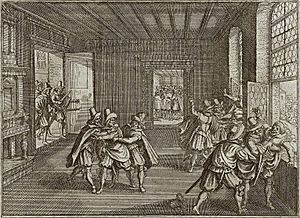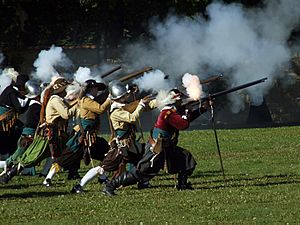Bohemian Revolt facts for kids
Quick facts for kids Bohemian Revolt |
|||||||
|---|---|---|---|---|---|---|---|
| Part of the Thirty Years' War | |||||||
 The Third Defenestration of Prague |
|||||||
|
|||||||
| Belligerents | |||||||
| Commanders and leaders | |||||||
|
|||||||
The Bohemian Revolt was a big uprising in the Kingdom of Bohemia (modern-day Czech Republic) between 1618 and 1620. It was a fight by the local nobles and important people, called "estates," against the powerful Habsburg dynasty. This revolt was a major event because it actually started the much larger and longer Thirty Years' War across Europe.
The main reasons for the revolt were disagreements about religion and power. Most of the Bohemian estates were Protestant, while the Habsburg rulers were strongly Catholic. They also argued about who should have more control: the local nobles or the emperor. The revolt ended with a big defeat for the Bohemians at the Battle of White Mountain. This led to Bohemia becoming more Catholic again. It also pulled other countries like Denmark and Sweden into the wider Thirty Years' War.
Contents
Why the Revolt Started
The Holy Roman Emperor, Emperor Matthias, had no children to take over after him. He wanted to make sure his cousin, Ferdinand of Styria, would become the next ruler. Ferdinand was a very strong Catholic. Matthias arranged for Ferdinand to be elected as the future King of Bohemia and Hungary while Matthias was still alive.
Many Protestant leaders in Bohemia were worried. They feared losing their religious freedoms. These rights had been given to them by an earlier emperor, Emperor Rudolf II, in a special document called the Letter of Majesty (1609). Instead of Ferdinand, some Protestants wanted Frederick V, a Protestant prince, to be their king.
However, not all Protestants agreed. Some supported Ferdinand. So, in 1617, Ferdinand was elected by the Bohemian estates. This meant he would automatically become the next King of Bohemia when Emperor Matthias died.
The Defenestration of Prague
After his election, Ferdinand sent two Catholic officials, Vilem Slavata and Jaroslav Bořita, to Prague Castle. They were supposed to govern Bohemia while he was away. On May 23, 1618, a group of Protestants captured these officials and their secretary, Philip Fabricius. They threw them out of a palace window, which was about 17 meters (56 feet) high!
Amazingly, all three survived, though they were injured. This event is known as the Third Defenestration of Prague. It was the spark that officially started the Bohemian Revolt. Soon, the conflict spread across all the lands of the Bohemian Crown, including Bohemia, Silesia, Lusatia, and Moravia.
The Conflict Spreads
If the Bohemian Revolt had stayed a small, local fight, it might have ended quickly. But Emperor Matthias died, which made the rebellious Protestant leaders bolder. They had been close to making a deal, but now they felt stronger.
The new Emperor, Ferdinand, needed help. He asked his cousin, King Philip III of Spain, for support. Spain had a strong interest in keeping the Holy Roman Empire stable. A key trade route, called the "Spanish Road," ran through the Empire. So, Spain spent a lot of money hiring soldiers to help Ferdinand.
The Bohemians desperately needed allies too. They asked to join the Protestant Union, a group led by Frederick V, their preferred choice for king. The Bohemians hinted that Frederick could become their king if he protected them. However, the Bohemians also made similar offers to other leaders. These included the Duke of Savoy, the Elector of Saxony, and the Prince of Transylvania.
The Austrians found out about these secret offers and made them public. This made many potential allies lose trust in the Bohemians, especially the court of Saxony. Even King James I of England refused to help Frederick, even though Frederick's wife was James's daughter.
Despite these problems with getting support, the revolt started well for the Bohemians. Many nobles in Upper and Lower Austria, who were Protestant, joined the rebellion. In 1619, a Bohemian army led by Count Thurn even reached the walls of Vienna, the capital city.
The Revolt Ends

To help the Emperor, Spain sent an army from Brussels led by Ambrogio Spinola. Also, the Spanish ambassador convinced Protestant Saxony to fight against Bohemia. In return, Saxony would gain control over Lusatia. Spain also invested a lot of money to pay for the armies. The Saxons invaded Bohemia, and the Spanish army kept the Protestant Union from helping.
The Catholic League's army, led by Count of Tilly, took control of Upper Austria. Meanwhile, Imperial forces under the Count of Bucquoy secured Lower Austria. These two armies then joined together and marched north into Bohemia.
The Battle of White Mountain
On November 8, 1620, Emperor Ferdinand II's forces completely defeated Frederick V's army at the Battle of White Mountain, near Prague. This was a huge victory for the Emperor. After this defeat, Bohemia remained under Habsburg rule for nearly 300 years. It also became almost entirely Catholic again.
This defeat caused the Protestant Union to break apart. Frederick V lost all his lands. He was declared an outlaw by the Holy Roman Empire, and his territories were given to Catholic nobles. His important title of Elector was given to his distant cousin, Duke Maximilian of Bavaria. Frederick, now without land, became a famous exile. He tried to get support for his cause from Sweden, the Netherlands, and Denmark.
The end of the Bohemian Revolt was a big setback for Protestants in the region. The rebellion's collapse led to many properties being taken from Bohemian nobles. This made sure the country returned to the Catholic side after more than 200 years of Protestant beliefs. However, even though Bohemia was now firmly controlled by the Emperor, other regions continued to fight for several more years. This drew more countries into the conflict, turning it into the long and devastating Thirty Years' War.
Images for kids
-
Contemporary painting showing the Battle of White Mountain (1620), where Pro-Habsburg forces under Johann Tserclaes, Count of Tilly won a decisive victory.
See also
 In Spanish: Revuelta bohemia para niños
In Spanish: Revuelta bohemia para niños
- Anti-Protestantism
- Counter-Reformation
- Hussite Wars
- Religion in the Czech Republic
- Thirty Years' War



